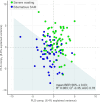Childhood severe acute malnutrition is associated with metabolomic changes in adulthood
- PMID: 33201860
- PMCID: PMC7819749
- DOI: 10.1172/jci.insight.141316
Childhood severe acute malnutrition is associated with metabolomic changes in adulthood
Abstract
BACKGROUNDSevere acute malnutrition (SAM) is a major contributor to global mortality in children under 5 years. Mortality has decreased; however, the long-term cardiometabolic consequences of SAM and its subtypes, severe wasting (SW) and edematous malnutrition (EM), are not well understood. We evaluated the metabolic profiles of adult SAM survivors using targeted metabolomic analyses.METHODSThis cohort study of 122 adult SAM survivors (SW = 69, EM = 53) and 90 age-, sex-, and BMI-matched community participants (CPs) quantified serum metabolites using direct flow injection mass spectrometry combined with reverse-phase liquid chromatography. Univariate and sparse partial least square discriminant analyses (sPLS-DAs) assessed differences in metabolic profiles and identified the most discriminative metabolites.RESULTSSeventy-seven metabolite variables were significant in distinguishing between SAM survivors (28.4 ± 8.8 years, 24.0 ± 6.1 kg/m2) and CPs (28.4 ± 8.9 years, 23.3 ± 4.4 kg/m2) (mean ± SDs) in univariate and sPLS-DA models. Compared with CPs, SAM survivors had less liver fat; higher branched-chain amino acids (BCAAs), urea cycle metabolites, and kynurenine/tryptophan (KT) ratio (P < 0.001); and lower β-hydroxybutyric acid and acylcarnitine/free carnitine ratio (P < 0.001), which were both associated with hepatic steatosis (P < 0.001). SW and EM survivors had similar metabolic profiles as did stunted and nonstunted SAM survivors.CONCLUSIONAdult SAM survivors have distinct metabolic profiles that suggest reduced β-oxidation and greater risk of type 2 diabetes (BCAAs, KT ratio, urea cycle metabolites) compared with CPs. This indicates that early childhood SAM exposure has long-term metabolic consequences that may worsen with age and require targeted clinical management.FUNDINGHealth Research Council of New Zealand, Caribbean Public Health Agency, Centre for Global Child Health at the Hospital for Sick Children. DST is an Academic Fellow and a Restracomp Fellow at the Centre for Global Child Health. GBG is a postdoctoral fellow of the Research Foundation Flanders.
Keywords: Cardiovascular disease; Diabetes; Metabolism.
Conflict of interest statement
Figures







Similar articles
-
Metabolomics in plasma of Malawian children 7 years after surviving severe acute malnutrition: "ChroSAM" a cohort study.EBioMedicine. 2019 Jul;45:464-472. doi: 10.1016/j.ebiom.2019.06.041. Epub 2019 Jun 27. EBioMedicine. 2019. PMID: 31255658 Free PMC article.
-
Metabolomic Changes in Serum of Children with Different Clinical Diagnoses of Malnutrition.J Nutr. 2016 Dec;146(12):2436-2444. doi: 10.3945/jn.116.239145. Epub 2016 Nov 2. J Nutr. 2016. PMID: 27807038 Free PMC article.
-
Molecular Evidence for Differential Long-term Outcomes of Early Life Severe Acute Malnutrition.EBioMedicine. 2017 Apr;18:274-280. doi: 10.1016/j.ebiom.2017.03.001. Epub 2017 Mar 8. EBioMedicine. 2017. PMID: 28330812 Free PMC article.
-
Liver fat in adult survivors of severe acute malnutrition.Sci Rep. 2022 Mar 7;12(1):3690. doi: 10.1038/s41598-022-07749-5. Sci Rep. 2022. PMID: 35256686 Free PMC article.
-
Ready-to-use therapeutic food (RUTF) for home-based nutritional rehabilitation of severe acute malnutrition in children from six months to five years of age.Cochrane Database Syst Rev. 2019 May 15;5(5):CD009000. doi: 10.1002/14651858.CD009000.pub3. Cochrane Database Syst Rev. 2019. PMID: 31090070 Free PMC article.
Cited by
-
Kynurenine Pathway in Diabetes Mellitus-Novel Pharmacological Target?Cells. 2023 Jan 31;12(3):460. doi: 10.3390/cells12030460. Cells. 2023. PMID: 36766803 Free PMC article. Review.
-
Impact of Early Childhood Malnutrition on Cardiometabolic Risk Factors in Young Adults from Marginalized Areas of Chiapas, Mexico.Nutrients. 2025 Jan 11;17(2):254. doi: 10.3390/nu17020254. Nutrients. 2025. PMID: 39861384 Free PMC article.
-
Defining Blood Plasma and Serum Metabolome by GC-MS.Metabolites. 2021 Dec 24;12(1):15. doi: 10.3390/metabo12010015. Metabolites. 2021. PMID: 35050137 Free PMC article. Review.
-
Geriatric nutrition risk index in the prediction of all-cause and cardiovascular mortality in older adults with hyperlipidemia: NHANES 1999-2018.BMC Geriatr. 2024 Jul 27;24(1):634. doi: 10.1186/s12877-024-05232-6. BMC Geriatr. 2024. PMID: 39068440 Free PMC article.
-
Faster rehabilitation weight gain during childhood is associated with risk of non-communicable disease in adult survivors of severe acute malnutrition.PLOS Glob Public Health. 2023 Dec 21;3(12):e0002698. doi: 10.1371/journal.pgph.0002698. eCollection 2023. PLOS Glob Public Health. 2023. PMID: 38127945 Free PMC article.
References
-
- UNICEF et al. Levels and Trends in Child Malnutrition: Key Findings of the 2019 Edition of the Joint Child Malnutrition Estimates. WHO. https://www.who.int/nutgrowthdb/jme-2019-key-findings.pdf 2019. Accessed November 16, 2020.
-
- Barker DJ. The developmental origins of adult disease. J Am Coll Nutr. 2004;23(suppl 6):588S–595S. - PubMed
Publication types
MeSH terms
LinkOut - more resources
Full Text Sources

